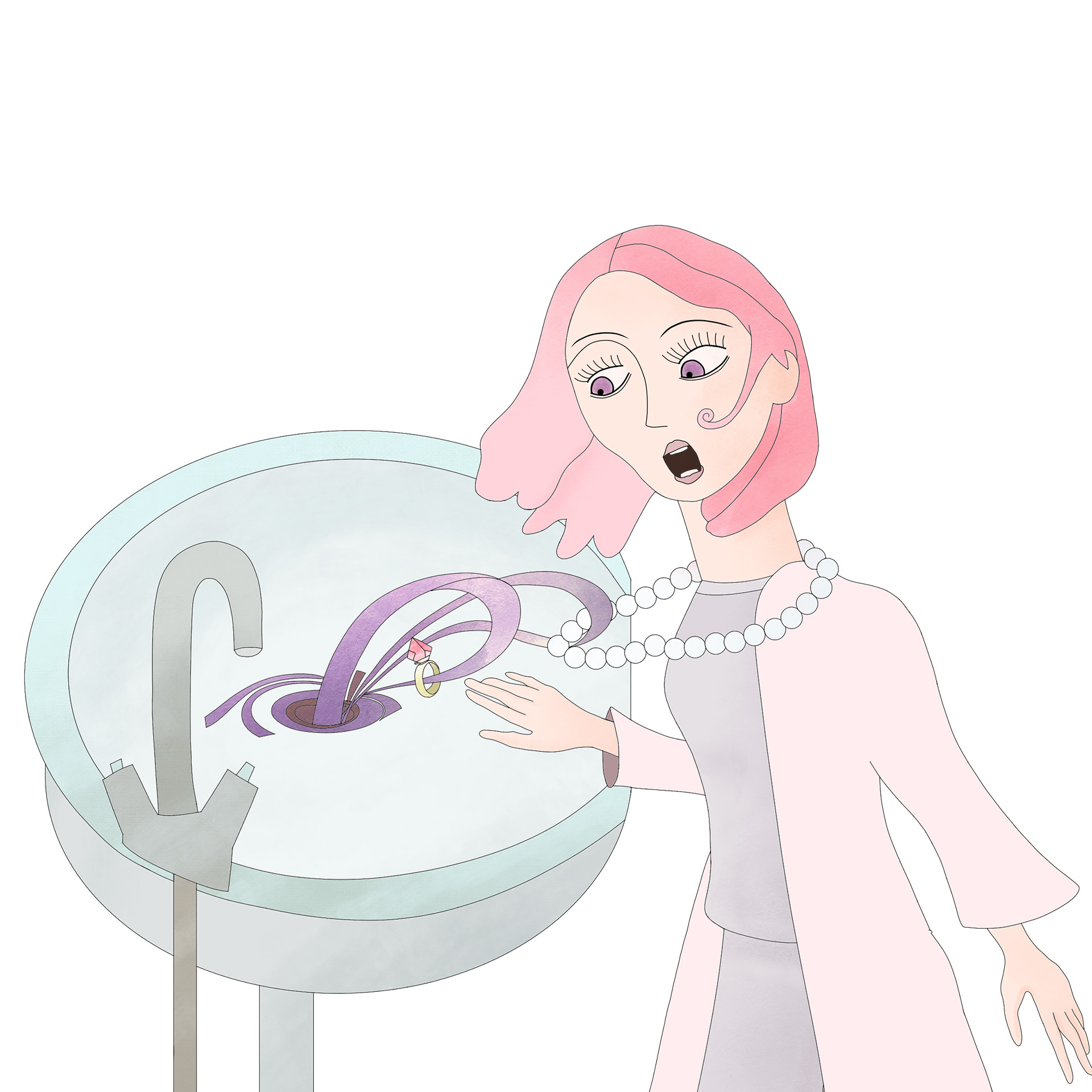Jewels Are Meant to Catch the Light
As Cleaning jewels is about finding the right method for the right jewel and about preventing dullness without creating damage. Cleaning methods for jewels depend on a piece’s gemstones, metals, finishes, and setting. It is very easy to apply the right remedy to the wrong jewel. What restores your silver may be devastating for certain gemstones.

How To Clean Gemstones At Home

Cleaning instructions for gems can vary significantly according to their nature.
Some gemstones are extra sensitive to heat, chemicals and thus, require a delicate approach. Other gems are able to resist ultrasound cleaning or even steam cleaning. Let us start with a list of things to avoid in general.
You should always avoid harsh chemicals like chlorine, bleach, turpentine, ammonia, and acetone. They can cause dramatic damage, in particular when it comes to softer and more porous gemstones. Beauty chemicals like hairspray, creams, cosmetics, and perfume can be dangerous especially for softer and organic gems like pearls.
Abrasive cleaning solutions; often used on silver should may cause serious harm to your gems by permanently damaging their surface and structure.
Precious & semi-precious stones safe for DIY cleaning
It is important to understand that a gemstone’s crystal structure is dependent entirely on its chemical composition. If you expose gems, especially if they are softer (scoring below 5 on the Mohs scale) and more porous to chemicals you can create undesirable effects such as cracks or discolouration. Acids can be devastating for softer gemstones such as malachite and organic gems such as pearls. This is due to the quality of porous gemstones to absorb small traces of liquids. These liquids can carry elements that are adverse to the gem’s chemical structure and cause cracks or discolouration.
Even water is not completely safe for softer gemstones. Leaving your gems in water for a short time will not cause instant damage. However, tap water typically contains chlorine and calc, amongst other damaging elements. If your gem is exposed to them for prolonged periods of time, they will be absorbed into the surface of the gem and eventually cause cracks. If your gem is in good condition, this absorption will probably not go much deeper than the surface. Once cracks begin to appear, you might have to re-polish your gem. However, if your gem already has internal fractures, dangerous elements will make it more fragile and prone to chipping. In that case, the gem may need to be recut entirely.
If you are serious about collecting and maintaining jewellery, your goal should be to pass down your jewels to generations to come. Therefore, you can not afford to be negligent. If you repeatedly submerge certain gemstones in water for very long periods of time, they will slowly fragilise over decades. Ultrasonic cleaners exponentially amplify the absorption process and any internal weaknesses that a gem already has. Do not clean your softer gemstones with ultrasounds! Your most sensitive gems should be gently cleaned with a damp and soft microfiber cloth instead.
Treated gemstones also require a delicate touch
Your treated gemstones, similarly to softer gemstones, require a delicate approach. Most colour and clarity enhancements improve a gem’s appearance by filling up fissures that reach all the way to the center of the gem. Oil, resin, silicon, or even dyed glass are used as a filling. If you use a normal cleaning process you will dissolve these fillings. We do not recommend buying such gemstones but if you already have one, it should be cleaned gently with a damp cloth to avoid the filling from becoming washed out.
Soft and porous stones require a more delicate approach
Diamonds, rubies, and sapphires are the safest gems to clean at home. The Gemological Institute of America suggests you should use warm soapy water and a soft baby brush to gently cleanse your gems.
It is also generally safe to use ultrasonic cleaners for harder gems (with a hardness above 6 on the Mohs scale), which have not been treated. After you are done, gently dry your gems with a soft cloth. If you just leave them to air dry, water and soap stains can appear, which will force you to do the process all over again.
Make sure you are not using an old toothbrush! They usually have traces of toothpaste that are abrasive and can damage your gems. You can use the same method to clean Amethyst, Aquamarine, Blue Topaz, Garnet, Peridot, Rose Quartz, Cubic Zirconia, and others.
If you are searching for a specific gemstone, our team has prepared a complete list of heat-sensitive gemstones. View our digital jewellery maintenance kit
Heat-sensitive gemstones
Many gemstones will react to heat. Indeed, you can change the colours of many gemstones with higher temperatures. This is a widely spread method to enhance the colour of sapphires and rubies because it makes them more affordable. Unheated gems are naturally more valuable and should be handled carefully. Ignoring heat sensitivity can make a jewel’s value suddenly drop! Heat can not only change the colour but also damage the internal structure of a gem by creating fissures that are considered inclusions. The stronger the heat, the larger the inclusions will be.
To put things into perspective, we have two real-life examples of heat lowering the value of a jewel:
The first one concerns a person who brought a fine aquamarine to us, which had slightly darkened after it had been steam-cleaned at home. Even though it visually seemed that the colour became nicer, the gemological laboratory came to the conclusion that the aquamarine’s colour had been artificially enhanced. Thus, when the aquamarine’s certificate was updated, the value of the gem had decreased.
Our second example concerns a couple who brought Bulgari sapphire earrings to us. The earrings had been damaged during a gold setting repair by an overconfident jeweller. He had put the sapphire under the flame while soldering the setting, Unfortunately, this caused permanent damage to the sapphires, which dramatically decreased their price.

Jewellery Cleaning Methods And Tools
The type of metal (gold, silver, or else), as well as the types of finish (enamel, pavé, or a simple polish), will also influence which cleaning methods should be used and which should be avoided. The next paragraphs will give you detailed cleaning guidelines
Loupe Inspection
The cleaning process should start with a loupe inspection. We believe every fine jewellery acquirer should own a small loop 10x. First, this will allow you to discover the world of colours and shapes inside a gem, as well as help you appreciate the fine craftsmanship of your jewels. A loupe is a very practical item that makes it easier to discover and clean dirt, but also to discover weaknesses in the jewel’s setting and gems.
Warm soapy water
You can use warm soapy water and a soft brush for every type of setting. This is the safest of all methods and is effective when you do it regularly. Certain types of jewels should only be cleaned this way, for example, enamel jewellery. After rinsing, avoid letting your jewel dry on its own. Instead, use a soft cloth to gently wipe it dry. You can also use a hairdryer on low heat to dry your jewels. This will avoid water stains showing on your jewel and even give it a bit of shine.
Cleaning solutions
If you prefer to use a specialised cleaning solution, we recommend that you buy a product made for the specific jewel you want to clean. Explicitly check if these products are safe for your gemstones. Many gems can be cleaned with most silver polishing kits. Brands such as Hagerty and Town Talk can easily be found online. They are also widely used by industry professionals.
We also recommend you clean your silver metals with professional silver polishing kits. There are dozens of homemade recipes online that promise magical results. We have professionally tested most of them and the results are far worse than what you will achieve with a silver polishing kit.
Some remedies may scratch your silver surfaces or fade plated ones. There can be a variety of undesirable secondary effects and the results do not last very long. A proper cleaning solution and a preventive storage method are the best options for your silverware’s longevity.

Polishing cloths
There are wiping and buffing cloths designed especially for shining jewellery. Using a buffing cloth you can gently wipe all the metal surfaces of your jewel. This type of cloth restores the brilliance of metals, due to its very mild abrasiveness. Frequent use of such polishing clothes will fade platings of golds after a while. Avoid it on rhodium-plated gold for example. Be careful to avoid your gemstones while buffing the setting of your jewel.
Ultrasonic cleaner
An ultrasonic cleaner consists of a recipient, filled with water and usually a cleaning solution. It produces vibrations in the form of ultrasound waves that detach dirt from your jewels. Place your jewel in the water. Switch on the device and let it work for a few minutes. The results are remarkable.
This option is usually safe, but it should be avoided with certain gems (see our section on soft and porous gems above) as well as certain settings. When finished, dry your jewel with a soft cloth or air dry on low heat. It will avoid water and soap marks.
Avoid ultrasonic cleaners for plated jewellery such as rhodium-plated items. Most white, rose, and yellow gold jewels are plated with rhodium to accentuate their colour. The colour will fade out with frequent use of an ultrasonic cleaner, leaving the gold below to become dotted. Even worse, an enamel finish will crack most of the time irreparably from the ultrasound waves.
Lastly, do not use ultrasonic cleaners for pavé gem-set jewellery. The tiny gems in your pavé setting are held by tiny prongs which can loosen under the ultrasonic waves. This frequently results in small gems falling out their prongs to the bottom of the ultrasonic cleaning device during cleaning.
Jewellery steam cleaner
An ultrasonic cleaner consists of a recipient, filled with water and usually a cleaning solution. It produces vibrations in the form of ultrasound waves that detach dirt from your jewels. Place your jewel in the water. Switch on the device and let it work for a few minutes. The results are remarkable.
This option is usually safe, but it should be avoided with certain gems (see our section on soft and porous gems above) as well as certain settings. When finished, dry your jewel with a soft cloth or air dry on low heat. It will avoid water and soap marks.
Avoid ultrasonic cleaners for plated jewellery such as rhodium-plated items. Most white, rose, and yellow gold jewels are plated with rhodium to accentuate their colour. The colour will fade out with frequent use of an ultrasonic cleaner, leaving the gold below to become dotted. Even worse, an enamel finish will crack most of the time irreparably from the ultrasound waves.
Lastly, do not use ultrasonic cleaners for pavé gem-set jewellery. The tiny gems in your pavé setting are held by tiny prongs which can loosen under the ultrasonic waves. This frequently results in small gems falling out their prongs to the bottom of the ultrasonic cleaning device during cleaning.
When To Visit A Professional Jeweller

If you are unsure of how to clean your jewel, seek advice from a professional. Regular and gentle cleaning at home is key to the longevity of your jewels. That said, a visit to the jeweller every now and then will further ensure that everything is in order. You should visit a jeweller every few years when your jewel needs a professional clean and polish. Any jeweller can make a quick polish to make your jewel nice and shiny. But it takes an excellent goldsmithing atelier to polish a jewel to near perfection.
See how a skilled jeweller takes care of your jewellery and what services a goldsmith atelier worthy of its name is able to offer Discover our atelier services today
Giving a mirror-like finish to a jewel is one of the most difficult tasks even for a skilled and experienced jeweller. This procedure should not be done too often. It removes a very thin layer of the surface of a jewel, therefore it will thin and fragilise your jewel if done too often.
When you suspect or find a weakness in the setting, stop wearing your jewel and have it inspected by your goldsmith. If a jewel has suffered a shock and there are no visible damages, you may still want to stop wearing it and let your goldsmith know what happened so that he can take a look at it accordingly.
Illustration & editorial by Daniel Román
We hope you’ve enjoyed this article and found it useful. This is first instalment of the Only Jewels 3 part guide concerning jewellery care.
- How To Keep Your Jewels Safe To Ensure Their Longevity?
- How Do Professional Jewellers Clean & Maintain Your Jewellery?











